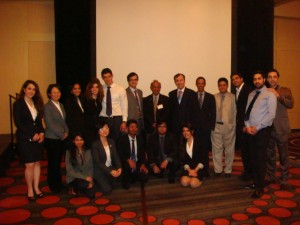May 2014, Vol. 69 No. 5
Newsline
Infrastructure, Energy Top CIGMAT 2014 Agenda

A one-day conference and exhibit was organized by the Center for Innovative Grouting Materials and Technology (CIGMAT) and the Department of Civil and Environmental Engineering, University of Houston, on “Infrastructure, Energy, Geotechnical, Flooding and Sustainable Issues Related to Houston & Other Major Cities” at the University of Houston on March 7.
More than 300 people participated in the 19th annual conference represented by owners, consulting engineers, material supplies, contractors and academia.
The convention opened with welcoming remarks by Dr. Cumaraswamy Vipulanandan, P.E., professor and director of CIGMAT and the Texas Hurricane Center for Innovative Technology (THC-IT).
The general session focused on highway transportation and public works infrastructure issues and the energy needs and potential method of production for the future. Several ongoing and new highway projects valued over several billion dollars with maintenance issues for the department of transportation were discussed as well as methods to minimize the highway accident deaths. Plans for maintaining and expanding Houston’s water, wastewater and other infrastructure facilities in a sustainable manner were discussed.
With global population growth necessitating more demand for oil and gas, attendees also hear about how new technologies and environmental regulations are affecting the use of hydraulic fracturing method in various rock formations to obtain oil and gas from deep geological formations. Keynote speakers included Michael Alford, district engineer for Houston, TxDOT; Daniel W. Krueger, director of Public Works for the city of Houston; and Kris Nygaard, senior stimulation consultant, ExxonMobil, Houston, TX.
Technical sessions
Speakers from around the country took part in four technical sessions. During the first panel discussion, “Water Issues and Hydraulic Fracturing,” Erika Mancha, engineer, Texas Water Development Board, discussed the methods that are being investigated for desalinization of sea water as recent drought conditions in Texas have resulted in TWDB looking at alternative methods of obtaining drinking water. Jun Chang, deputy director, city of Houston, discussed the successes and continued challenges in the regional and state surface water plans. The need for integrated network of pipelines to meet the requirements also was discussed. Dr. Vipulanandan discussed the current use of over 75 billion gallons of water annually in hydraulic fracturing in the United States and potential methods to treat them using conventional methods including electro coagulations and filtering.
The second session explored flooding, maintenance and geotechnical issues by guest speakers Mike Talbott, director, Harris County flood Control; Dale Rudick, deputy director of the Houston’s public works and engineering department; and Kenneth Tand from Kenneth Tand and Associates. Topics included the Memorial Park Demonstration Project; funding for and efforts to make better, sustainable streets and drainage systems under the Rebuild Houston plan; and case studies highlighted using the Potential Vertical Rise (PVR) method used to predict the behavior of swelling clay soils.
President David Daniel, University of Texas at Dallas, delivered the ninth Mike O’Neill Lecture on the “Deepwater Horizon Accident.” Presented were the findings from the committee and the lessons learned from the disaster. Dr. Vipulanandan followed with a presentation on “Development of Smart Cement for Real-Time Monitoring of Oil Well Cementing Applications.” The smart cement currently being developed at CIGMAT has high sensing and piezoresistive properties so it can be monitored from the time of placement to the service life. The audience heard out this capability can improve the level of monitoring to minimize the failures that occur due to cement failure, including what happened at Deepwater Horizon.
The final session on “New Technologies for Maintaining and Monitoring” highlighted issues related to in-place evaluation of water pipeline conditions and life expectancy, consideration of Houston’s pavement design standards and extending the lifecycle of storm water culverts utilizing organic/inorganic materials. Speakers included Aldo Ranzani, Public Works and Department, city of Austin; Mike Pezeshki, managing engineer, Public Works and Engineering Department for the city of Houston; and Michael Vargo, technical consultant for Barton Industries, Atlanta, GA.
Vipulanandan, standing center in back row, with CIGMAT graduate students.

A reception was held in the exhibit area where posters were on view relating to research activities at CIGMAT and in the Department of Civil and Environmental Engineering. A number of grouting, pipe manufacturers, material suppliers, pipe condition monitoring and waste water rehabilitation companies participated in the exhibition.
For conference proceedings, visit cigmat.cive.uh.edu. CIGMAT 2015 will be held on March 6 at the University Hilton, University of Houston.




Comments